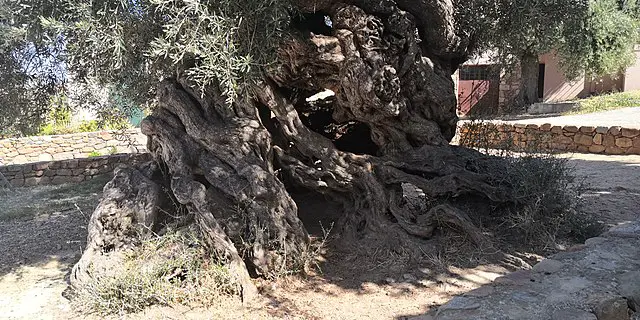The Olive Tree That Time Forgot: Crete’s Ancient Sentinel
Imagine standing beneath a tree that sprouted before the Parthenon was built, before Rome was founded, even before Homer composed the Iliad. In the quiet village of Ano Vouves, Crete, such a tree exists—a living relic known as the Olive Tree of Vouves.
A Living Monument
The Olive Tree of Vouves is estimated to be between 2,000 and 4,000 years old. Its exact age is uncertain due to the loss of heartwood over millennia, which prevents precise dating methods like radioisotope analysis. However, its immense size and the presence of nearby ancient cemeteries from the Geometric Period (circa 900–700 BCE) suggest a venerable age.
Despite its age, the tree remains productive, bearing olives to this day. It was grafted with the ‘Tsounati’ cultivar, a variety native to Crete, ensuring its continued vitality.
A Symbol of Heritage
In 1997, the Olive Tree of Vouves was declared a protected natural monument. To honor its significance, the Olive Tree Museum of Vouves was established nearby in 2009. Housed in a 19th-century building, the museum showcases traditional tools and methods of olive cultivation, offering visitors a glimpse into the region’s rich agricultural history.
Branches from the tree have been used to create victory wreaths for the Olympic Games, including the 2004 Athens Olympics and the 2008 Beijing Olympics, linking the ancient past with contemporary global events.
Still Grafting, Still Growing
Despite its age, the Olive Tree of Vouves hasn’t retired. It still bears fruit every year, thanks to a local variety called Tsounati, one of the oldest olive cultivars in Crete. It’s been grafted, of course, no tree lives that long without a little human help. But still, it’s producing olives. Think about that the next time you feel too tired to water your houseplant.
Its leaves have even made it to the Olympics. In both the 2004 Athens Games and the 2008 Beijing Games, branches from this very tree were used to create victory wreaths. That’s right, athletes who’d trained for decades were crowned with twigs from something that predates written Greek language. Talk about connecting past and present in one beautiful, slightly crunchy circle.
Olive Trees Are Basically Time Machines
Standing next to the tree in Vouves, you get this weird, quiet sense of time collapsing. Your phone doesn’t matter. That text can wait. This tree has stood through the rise and fall of Alexander the Great, the Roman conquest of Greece, the Byzantine Empire, the Ottoman Empire, two World Wars, and the invention of TikTok. (Honestly, surviving TikTok might be its greatest feat.)
Its trunk looks like a sculpture, twisted like an old man’s hands, split in places, hollow in others. Some say it looks haunted. Others think it looks like a tree that knows all your secrets and is just choosing to stay quiet about them.
It’s not just old, it feels wise.
A Village, a Museum, a Legacy
Today, the Olive Tree of Vouves is protected as a natural monument by the Greek government. The locals clearly love it, there’s a whole museum next to it, the Olive Tree Museum of Vouves, where you can learn about traditional olive oil production, see old farming tools, and get a feel for just how central the olive has been to Mediterranean life.
And yes, there’s a gift shop.
But the tree itself is free to visit. No ticket needed. Just show up, walk around its roots, maybe press your hand to the ancient bark and feel something stir in your chest. Awe? Reverence? That vague itch to start a farm and grow your own food? All normal reactions.
A Testament to Resilience
The Olive Tree of Vouves stands as a testament to nature’s endurance and the deep-rooted traditions of Crete. Its gnarled trunk and enduring fruitfulness embody the resilience of life through the ages. For visitors to Crete, a visit to this ancient tree offers a tangible connection to the island’s storied past and a moment of reflection on the passage of time.
Sources:
1. Olive Tree of Voues. Wikipedia

